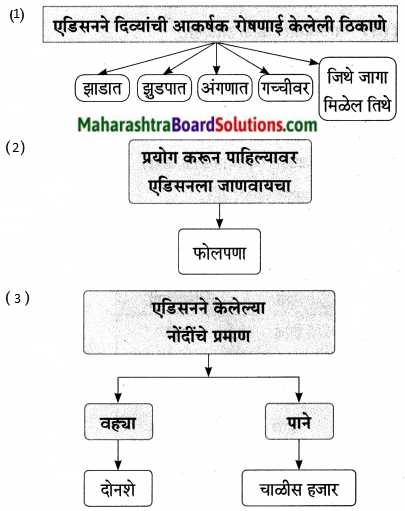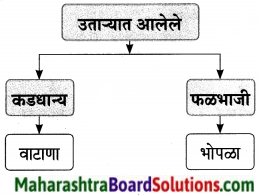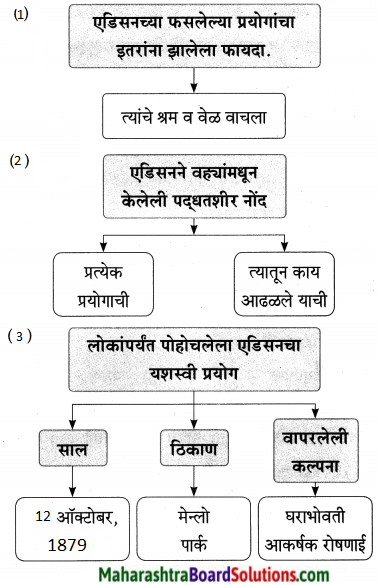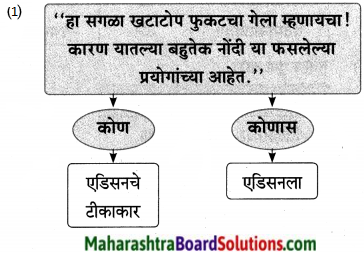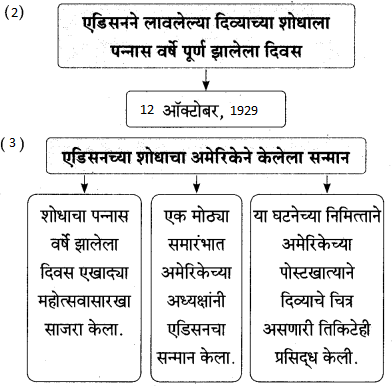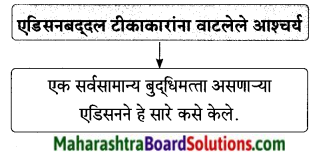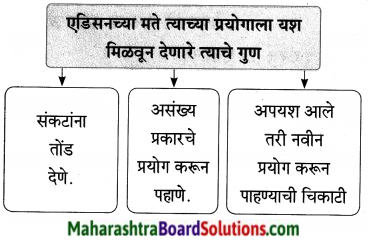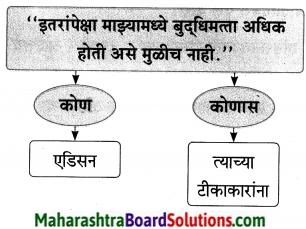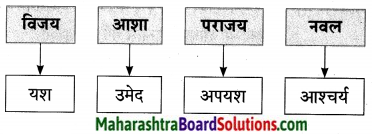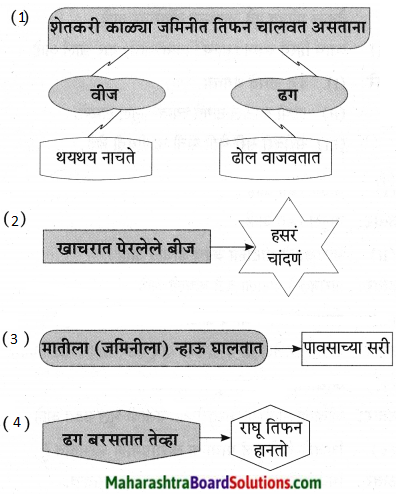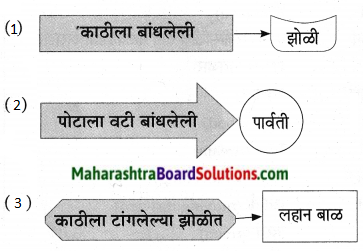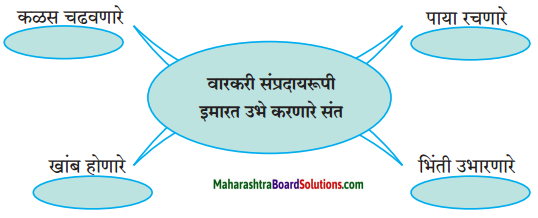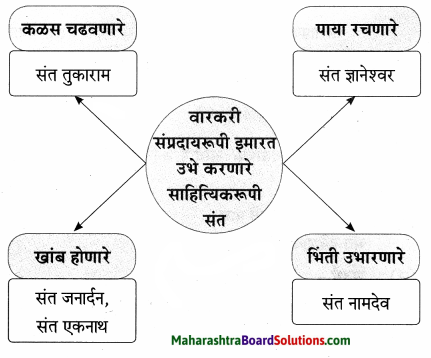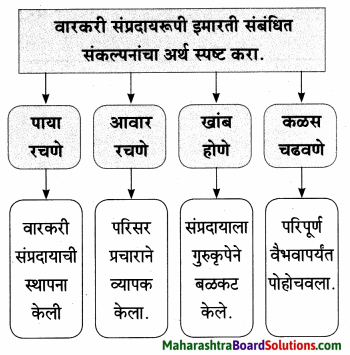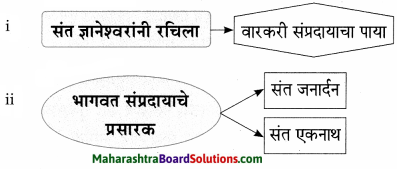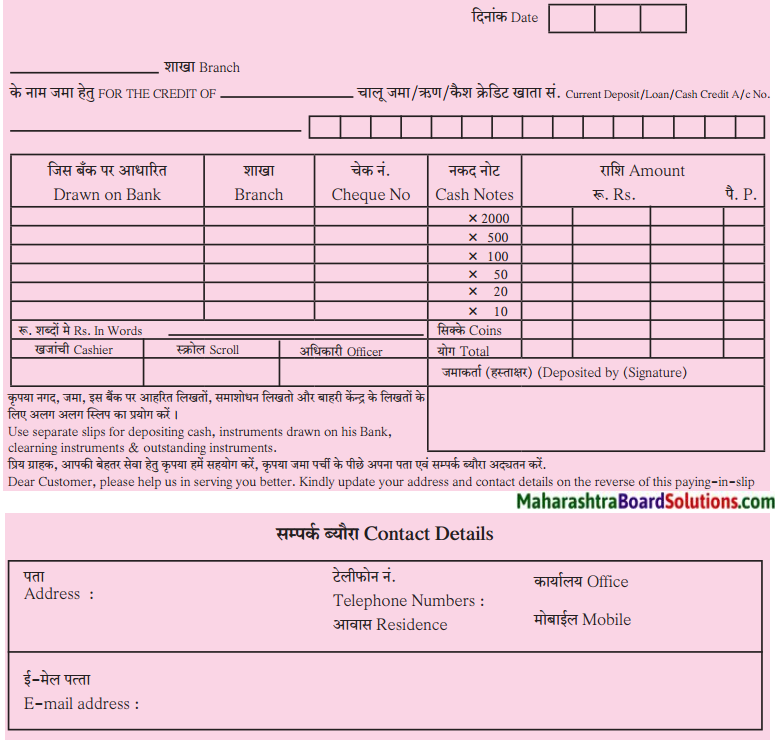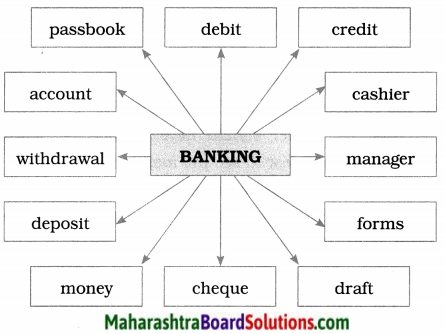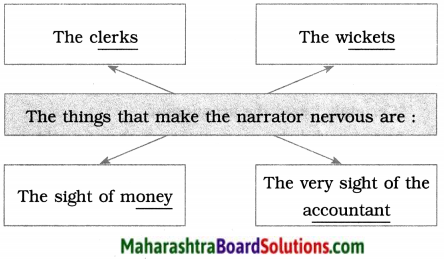98Balbharti Maharashtra State Board Class 9 Marathi Solutions Aksharbharati Chapter 16 शब्दांचा खेळ Notes, Textbook Exercise Important Questions and Answers.
Class 9 Marathi Aksharbharati Chapter 16 शब्दांचा खेळ Question Answer Maharashtra Board
शब्दांचा खेळ Std 9 Marathi Chapter 16 Questions and Answers
1. खालील वाक्यांचा अर्थ स्पष्ट करा.
प्रश्न (अ)
बाहुलीचे शेकोटीजवळ लोटलेले तुकडे हेलनने गोळा केले.
उत्तरः
हेलनने रागाच्या भरात बाहुली बाईंकडून हिसकावून ती जमिनीवर आपटली. त्यामुळे बाहुलीचे तुकडे तुकडे झाले होते. पण बाईंच्या सान्निध्यात लेखिकेला एक नवीन दृष्टी मिळाली होती. त्यामुळे आपल्या हातून घडलेल्या चुकीची लेखिकेला जाणीव झाली व वाईटही वाटले. दारापाशी येताच तिला त्या बाहुलीची आठवण आली. त्यामुळेच बाहुलीचे शेकोटीजवळ लोटलेले तुकडे हेलनने गोळा केले.

प्रश्न (आ)
हव्याशा क्षणी हेलन प्रेमाच्या प्रकाशात न्हाऊन निघाली.
उत्तरः
बाई-अनी मॅन्सफिल्ड सुलिव्हॅन जीवनात येण्यापूर्वी हेलनचे मन राग व कडवटपणानं भरलेले होते. स्वत:च्या भविष्यासाठी स्वत:शीच चाललेल्या सततच्या झगड्यानं हेलन थकून गेली होती. तिचं आयुष्य म्हणजे धुक्यात सापडलेल्या जहाजासारखे झाले होते. होकायंत्र व बंदर याबद्दल हेलनला काहीच कल्पना नव्हती. अशा या निराश, भवितव्य नसलेल्या आयुष्यात अगदी योग्य वेळी बाई ॲनी मॅन्सफिल्ड सुलिव्हॅन यांचा प्रवेश झाला, ज्यांनी हेलनच्या जीवनात मायेची पाखर घातली. अक्षर, शब्द यांचे ज्ञान झाले. त्यामुळे हेलनच्या जीवनात शिक्षणाचा प्रवेश झाला. म्हणून लेखिका हेलन सांगते हव्याशा क्षणी हेलन प्रेमाच्या प्रकाशात न्हाऊन निघाली.
2. w-a-t-e-r शब्द हेलन कशी शिकली हे लिहून आकृती पूर्ण करा.
प्रश्न 1.
w-a-t-e-r शब्द हेलन कशी शिकली हे लिहून आकृती पूर्ण करा.

उत्तरः
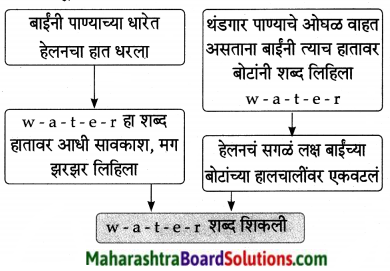
3. जोड्या जुळवा.
प्रश्न 1.
जोड्या जुळवा.
| ’अ’ गट |
‘ब’ गट |
| 1. आतुर होणे |
(अ) खूप आनंद होणे |
| 2. हिरमोड होणे |
(ब) प्रेम करणे |
| 3. उकळ्या फुटणे |
(क) उत्सुक होणे |
| 4. पालवी फुटणे |
(ड) नाराज होणे |
| 5. मायेची पाखर घालणे |
(इ) नवीन उत्साह निर्माण होणे |
उत्तरः
| ’अ’ गट |
‘ब’ गट |
| 1. आतुर होणे |
(क) उत्सुक होणे |
| 2. हिरमोड होणे |
(ड) नाराज होणे |
| 3. उकळ्या फुटणे |
(अ) खूप आनंद होणे |
| 4. पालवी फुटणे |
(इ) नवीन उत्साह निर्माण होणे |
| 5. मायेची पाखर घालणे |
(ब) प्रेम करणे |

4. फरक स्पष्ट करा.
प्रश्न 1.
फरक स्पष्ट करा.

उत्तर:

5. खालील गटातील लेखननियमांनुसार योग्य शब्द लिहा.
प्रश्न 1.
खालील गटातील लेखननियमांनुसार योग्य शब्द लिहा.
(अ) शिरीष, शिरिश, शिरीश, शीरीष = [ ]
(आ) पुनर्वसन, पूनर्वसन, पुनर्वसन, पुनरवसन = [ ]
(इ) पारांपारिक, पारंपरिक, पारंपारीक, पारंपरीक = [ ]
(ई) क्रिडांगण, क्रीडांगण, क्रिडागण, क्रिडांगन = [ ]
उत्तर:
(अ) शिरीष
(आ) पुनर्वसन
(इ) पारंपरिक
(ई) क्रीडांगण
6. खालील वाक्यांतील काळ ओळखा.
प्रश्न 1.
खालील वाक्यांतील काळ ओळखा.
(अ) काल शब्द शिकून घेतले.
(आ) सकाळी आई माझ्या खोलीत येऊन गेली.
(इ) आयुष्यात पहिल्यांदाच मला उदया कधी उगवेल याची उत्कंठा लागली.
उत्तर:
(अ) भूतकाळ
(आ) भूतकाळ
(इ) भूतकाळ
7. स्वमत.
प्रश्न 1.
तुमच्या मते हेलन केलर आयुष्यात पहिल्यांदा ’उदयाची’ वाट का पहात असेल?
उत्तर:
उतारा 6 मधील कृती 4 : स्वमतचे उत्तर पहावे
प्रश्न 2.
‘अनी सुलिव्हॅन नसत्या तर हेलन घडली नसती’ विधानाची सत्यता पटवून दया.
उत्तरः
उतारा 4 मधील कृती 4 : स्वमतचे उत्तर पहावे

8. अभिव्यक्ती
प्रश्न 1.
तुमच्या मते दिव्यांग मुलांना भाषाशिक्षणात येणारे संभाव्य अडथळे लिहा.
उत्तरः
कोणतीही भाषा शिकताना त्या भाषेची मुळाक्षरे त्यांचे उच्चार माहीत असणे किंवा शिकणे अतिशय आवश्यक असते. जर मुलगा किंवा मुलगी यांना बहिरेपणा असेल तर उच्चारातील आवाज, स्वर ऐकू न आल्याने मुळाक्षरांचे उच्चार ज्ञान होत नाही. मुलगा किंवा मुलगी यांना अंधत्व असेल तर अक्षर ओळखही होत नाही. मुकेपणा जर मुलांमध्ये असेल तर मुळाक्षरांचे, शब्दांचे उच्चार ज्ञान होत नाही. बोलणे, वाचणे, लिहिणे, ऐकणे यातून भाषेचे ज्ञान व भाषेची समृद्धी मुलांना प्राप्त होत असते. परंतु दिव्यांग मुलांना मात्र त्यांच्यातील शारीरिक अपंगत्वामुळे भाषाशिक्षणास मुकावे लागते.
प्रश्न 2.
’सर्वसामान्य मुलांबरोबर दिव्यांग मुलांना शिक्षणाची समान संधी दयायला हवी’. या विचाराचे सामाजिक महत्त्व जाणा व ते शब्दबद्ध करा.
उत्तरः
उतारा 5 मधील कृती 4 : स्वमतचे उत्तर पहावे.
Marathi Akshar Bharati Class 9 Textbook Solutions Chapter 16 शब्दांचा खेळ Additional Important Questions and Answers
1. पुढील उताऱ्याच्या आधारे दिलेल्या सूचनेनुसार कृती करा:
कृती 1 : आकलन कृती
प्रश्न 1.
आकृतिबंध पूर्ण करा.
उत्तर:


प्रश्न 2.
उत्तर लिहा.
उत्तर:

उताऱ्यानुसार घटनांचा क्रम लावा.
प्रश्न 1.
- लेखिका दारापाशी जाऊन पायऱ्यांवर वाट पाहत राहिली.
- त्या दिवशी लेखिका दुपारी पोर्चमध्ये उभी होती.
- काहीतरी वेगळं घडणार याचा लेखिकेला साधारण अंदाज आला होता.
उत्तर:
- त्या दिवशी लेखिका पोर्चमध्ये उभी होती.
- काहीतरी वेगळं घडणार याचा लेखिकेला साधारण अंदाज आला होता.
- लेखिका दारापाशी जाऊन पायऱ्यांवर वाट पाहत राहिली.
खालील प्रश्नांची उत्तरे एका वाक्यात लिहा.
प्रश्न 1.
लेखिकेच्या जीवनातील महत्त्वाचा दिवस कोणता?
उत्तर:
शिक्षिका ॲनी मॅन्सफिल्ड सुलिव्हॅन ज्या दिवशी लेखिकेला शिकवायला आल्या तो दिवस लेखिकेच्या जीवनातील अतिशय महत्त्वाचा दिवस होता.
प्रश्न 2.
लेखिकेला कशाची कल्पना नव्हती?
उत्तर:
लेखिकेला भविष्यात तिच्यासाठी काय चमत्कार लिहून ठेवलाय याची कल्पना नव्हती.
प्रश्न 3.
3 मार्च, 1887 रोजी दुपारी लेखिका कोठे उभी होती?
उत्तरः
3 मार्च, 1887 रोजी दुपारी लेखिका पोर्चमध्ये उभी होती.

प्रश्न 4.
लेखिकेला आठवं वर्ष लागायला किती महिने बाकी होते?
उत्तर:
लेखिकेला आठवं वर्ष लागायला तीन महिने बाकी होते.
प्रश्न 5.
लेखिकेची बोटं कळ्यांवरून कशी फिरली?
उत्तरः
वसंत ऋतूचं स्वागत करायलाच उमलाव्यात तशी लेखिकेची बोटं कळ्यांवरून फिरली.
प्रश्न 6.
कंसातील योग्य शब्द वापरून रिकाम्या जागा भरा.
- भविष्यात माझ्यासाठी काय ……लिहून ठेवलाय, याची काही मला कल्पना नव्हती. (अभिवादन, नमस्कार, आशीर्वाद, चमत्कार)
- म्हणून मी दारापाशी जाऊन …………. वाट पाहत राहिले. (आतुरतेने, पायऱ्यांवर, खिडकीपाशी, पोर्चवर)
- मला आठवं वर्ष लागायला …………. महिने बाकी हो. (एक, चार, तीन, पाच)
उत्तर:
- चमत्कार
- पायऱ्यांवर
- तीन
कृती 2. आकलन कृती
योग्य पर्याय निवडून विधाने पूर्ण करा.
प्रश्न 1.
आयुष्यातला महत्त्वाचा दिवस म्हणजे माझ्या …………………….
(अ) बाई सुलिव्हॅन अॅनी मॅन्सफिल्ड मला शिकवायला आल्या तो दिवस.
(ब) बाई मॅन्सफिल्ड सुलिव्हॅन अॅनी मला शिकवायला आल्या तो दिवस.
(क) बाई ॲनी मॅन्सफिल्ड सुलिव्हॅन मला शिकवायला आल्या तो दिवस.
(ड) बाई मॅन्सफिल्ड अॅनी सुलिव्हॅन मला शिकवायला आल्या तो दिवस.
उत्तर:
आयुष्यातला महत्त्वाचा दिवस म्हणजे माझ्या बाई ॲनी मॅन्सफिल्ड सुलिव्हॅन मला शिकवायला आल्या तो दिवस.
प्रश्न 2.
भविष्यात माझ्यासाठी काय चमत्कार लिहून ठेवलाय, …………….
(अ) याची काही मला कल्पना नव्हती.
(ब) याची काही मला कल्पना होती.
(क) याची काही मला हळूहळू कल्पना आली होती.
(ड) याची मला पुरेपूर कल्पना होती.
उत्तरः
भविष्यात माझ्यासाठी काय चमत्कार लिहून ठेवलाय, याची काही मला कल्पना नव्हती.

प्रश्न 3.
कोण ते लिहा.
उत्तरः

प्रश्न 4.
सत्य वा असत्य ते लिहा. -
1. लेखिका दारापाशी जाऊन पायऱ्यांवर वाट पाहत राहिली.
2. लेखिकेला आठवं वर्ष लागायला पाच महिने बाकी होते.
उत्तर:
1. सत्य
2. असत्य
कृती 3: व्याकरण कृती
खालील वाक्ये लेखननियमांनुसार शुद्ध करून लिहा.
प्रश्न 1.
मला आठवं वर्ष लागायला तिन महीने बाकी होते.
उत्तरः
मला आठवं वर्ष लागायला तीन महिने बाकी होते.
प्रश्न 2.
दोन अगदी परस्परविरोधि आयूष्यं कशी एकत्र येतात.
उत्तरः
दोन अगदी परस्परविरोधी आयुष्यं कशी एकत्र येतात.
प्रश्न 3.
उताऱ्यातील दोन विशेषणे/नामे/सर्वनामे शोधून लिहा.
उत्तर:
- सर्वनामे: मी, माझ्या, मला, माझी
- नामे: आई, पोर्च, दार, पायरी, ऊन
- विशेषणे: शांत, लगबग
प्रश्न 4.
अचूक शब्द लिहा.
1. भविषयात, भवीष्यात, भविष्यात, भवविष्यात
2. चमत्कार, चमतकार, चत्मकार, चममकार
उत्तर:
1. भविष्यात
2. चमत्कार

खालील शब्दांसाठी पाठात आलेले समान अर्थाचे शब्द शोधा.
प्रश्न 1.
खालील शब्दांसाठी पाठात आलेले समान अर्थाचे शब्द शोधा.
उत्तर:
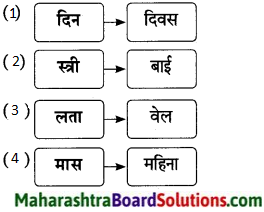
प्रश्न 5.
विरुद्धार्थी शब्द लिहा.
-
- असाधारण ×
- सावली ×
- रात्र ×
- शांत ×
उत्तर:
- साधारण
- ऊन
- दिवस
- अशांत
प्रश्न 6.
उताऱ्यातील दोन अनेकवचनी शब्द शोधून लिहा.
उत्तर:
- महिने
- पायऱ्या
- जाळ्या
- सवयी
- कळ्यां
- खाणाखुणा
- आठवणी
- बोटं

प्रश्न 7.
तक्ता पूर्ण करा.
उत्तर:
| शब्द |
प्रत्यय |
विभक्ती |
| भविष्यात |
त |
सप्तमी (एकवचन) |
| वेलीच्या |
च्या |
षष्ठी (एकवचन) |
प्रश्न 8.
तक्ता पूर्ण करा.
उत्तर:
| शब्द |
मूळ शब्द |
सामान्यरूप |
| आठवणीतला |
आठवण |
आठवणी |
| सवयीच्या |
सवय |
सवयी |
खालील वाक्यांत कंसातील वाक्प्रचारांचा वापर करा. (नवल वाटणे, कल्पना नसणे)
प्रश्न 1.
1. भविष्यात काय करायचे आहे याची रमेशला काहीही माहिती नव्हती.
2. आकाशात पसरलेलं इंद्रधनुष्य पाहून सर्वांना आश्चर्य वाटले.
उत्तर:
1. भविष्यात काय करायचे आहे याची रमेशला काहीही कल्पना नव्हती.
2. आकाशात पसरलेलं इंद्रधनुष्य पाहून सर्वांना नवल वाटले.
काळ बदला.
प्रश्न 1.
याची काही मला कल्पना नव्हती. (भविष्यकाळ करा)
उत्तर:
याची काही कल्पना मला नसेल.

प्रश्न 2.
आज काहीतरी वेगळं घडणार याचा मला साधारणअंदाज आला. (भविष्यकाळ करा)
उत्तर:
आज काहीतरी वेगळं घडणारं याचा मला साधारण अंदाज येईल.
प्रश्न 3.
पर्यायी शब्द लिहा.
उत्तर:

कृती 4 : स्वमत
प्रश्न 1.
तुमच्या आठवणीतला महत्त्वाचा दिवस कोणता व का याबद्दल तुमचे विचार व्यक्त करा.
उत्तर:
माझ्या आठवणीतला महत्त्वाचा दिवस 10 डिसेंबर, 2015 आहे. त्याला कारणही तसेच आहे. या दिवशी मला आंतर- विदयालयीन भाषण स्पर्धेत प्रथम पारितोषिक मिळाले व ते ही महाराष्ट्र राज्याच्या मुख्यमंत्र्यांच्या हस्ते! मला आतापर्यंतच्या विदयार्थी जीवनात मिळालेले हे पहिलेच बक्षीस होते. त्यामुळे मला या दिवसाचे विशेष आकर्षण आहे. प्रथमच आयुष्यात मिळालेल्या पहिल्या यशाचा हा दिवस आहे. तो मी कधी विसरणे शक्यच नाही. मला आजही आठवतोय तो दिवस. माझे भाषण ऐकून सर्वांनी माझे कौतुक केले. स्वतः मुख्यमंत्र्यांनी माझे भाषण ऐकून भविष्यात मला नेता होण्यास सांगितले. म्हणून हा माझ्या आयुष्यातील महत्त्वाचा दिवस आहे.
पुढील उताऱ्याच्या आधारे दिलेल्या सूचनेनुसार कृती करा:
कृती 1 : आकलन कृती
प्रश्न 1.
आकृतिबंध पूर्ण करा.
उत्तर:
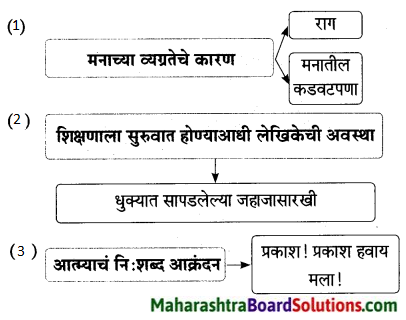
प्रश्न 2.
जोड्या जुळवा.
| ’अ’ गट |
‘ब’ गट |
| 1. मग्न |
(अ) धडधडत |
| 2. दाट |
(ब) प्रेमाचा |
| 3. छाती |
(क) व्यग्र |
| 4. प्रकाश |
(ड) धुकं |
उत्तर:
| ’अ’ गट |
‘ब’ गट |
| 1. मग्न |
(क) व्यग्र |
| 2. दाट |
(ड) धुकं |
| 3. छाती |
(अ) धडधडत |
| 4. प्रकाश |
(ब) प्रेमाचा |

प्रश्न 3.
उताऱ्यानुसार घटनांचा क्रम लावा.
- प्रेमाच्या प्रकाशात लेखिका न्हाऊन निघाली.
- लेखिकेच्या आत्म्याचं नि:शब्द आक्रंदन चालायचं.
- लेखिकेकडे होकायंत्र वगैरे काहीचं नव्हतं.
- मन रागानं आणि कडवटपणानं व्यग्र झालं होतं.
उत्तर:
- मन रागानं आणि कडवटपणानं व्यग्र झालं होतं.
- लेखिकेकडे होकायंत्र वगैरे काहीचं नव्हतं.
- लेखिकेच्या आत्म्याचं नि:शब्द आक्रंदन चालायचं
- प्रेमाच्या प्रकाशात लेखिका न्हाऊन निघाली.
खालील प्रश्नांची उत्तरे एका वाक्यात लिहा.
प्रश्न 1.
लेखिका कशाने थकून गेली होती?
उत्तरः
लेखिका स्वत:शीच चाललेल्या सततच्या झगड्यानं अगदी थकून गेली होती.
प्रश्न 2.
शिक्षणाला सुरुवात होण्यापूर्वी लेखिकेची अवस्था कशी होती?
उत्तरः
शिक्षणाला सुरुवात होण्याआधी लेखिकेची अवस्था धुक्यात सापडलेल्या जहाजासारखी होती.

प्रश्न 3.
लेखिका कशाच्या प्रकाशात न्हाऊन निघाली?
उत्तर:
लेखिका प्रेमाच्या प्रकाशात न्हाऊन निघाली.
प्रश्न 4.
कंसातील योग्य शब्द वापरून रिकाम्या जागा भरा.
- नेमक्या त्याच हव्याश्या क्षणी ………….. प्रकाशात मी न्हाऊन निघाले. (मोकळ्या, अंधकार, प्रेमाच्या, रागाच्या)
- किनारा गाठेपर्यंत ….………….. असतो. q(ताण, त्रास, व्यग्र, धुकं)
- छाती ……….…. असते. (घाबरत, धडधडत, धडपडत, धबधबत)
- असं माझ्या ……………… नि:शब्द आक्रंदन चालायचं. (जीवनाचं, आत्म्याचं, मनाचं, जीवाचं)
उत्तर:
- प्रेमाच्या
- ताण
- धडधडत
- आत्म्याचं
कृती 2 : आकलन कृती
योग्य पर्याय निवडून विधाने पूर्ण करा.
प्रश्न 1.
शिक्षणाला सुरुवात होण्याआधी माझी अवस्था ……………..
(अ) त्या धुक्यात न सापडलेल्या जहाजासारखी होती.
(ब) त्या धुक्यात सापडलेल्या बोटीसारखी होती.
(क) त्या धुक्यात न सापडलेल्या बोटीसारखी होती.
(ड) त्या धुक्यात सापडलेल्या जहाजासारखी होती.
उत्तरः
शिक्षणाला सुरुवात होण्याआधी माझी अवस्था त्या धुक्यात सापडलेल्या जहाजासारखी होती.

प्रश्न 2.
सहज स्पर्श करता येईल अशा पांढऱ्या …………..
(अ) अंधारानं आपल्याला वेढलंय आणि तशा धुक्यातून जहाज वाट काढत किनाऱ्याच्या विरूद्ध दिशेनं येत असतं.
(ब) अंधारानं आपल्याला वेढलंय आणि तशा धुक्यातून जहाज वाट काढत किनाऱ्याच्या दिशेनं येत असतं.
(क) अंधारानं आपल्याला वेढलंय आणि तशा धुक्यातून जहाज वाट न काढता किनाऱ्याच्या दिशेनं येत असतं.
(ड) अंधारानं आपल्याला वेढलंय आणि तशा धुक्यातून जहाज वाट न काढता किनाऱ्याच्या विरूद्ध दिशेनं येत असतं.
उत्तरः
सहज स्पर्श करता येईल अशा पांढऱ्या अंधारानं आपल्याला वेढलंय आणि तशा धुक्यातून जहाज वाट काढत किनाऱ्याच्या दिशेनं येत असतं.
प्रश्न 3.
परिच्छेदावरून खालील विधाने चूक की बरोबर ते लिहा.
- स्वत:शीच चाललेल्या सततच्या झगड्यानं लेखिकाअगदी थकून गेली होती.
- किनारा गाठेपर्यंत ताण नसतो.
- लेखिकेकडे होकायंत्र असल्यामुळे बंदर किती जवळ आहे हे काळायला मार्ग होता.
उत्तर:
- बरोबर
- चूक
- चूक
कृती 3 : व्याकरण कृती
खालील वाक्ये लेखननियमांनुसार शुद्ध करून लिहा.
प्रश्न 1.
कीनारा गाठेपरर्यत ताण असतो.
उत्तरः
किनारा गाठेपर्यंत ताण असतो.

प्रश्न 2.
स्वत:शीच चाललेल्या सततच्या झगड्यानं मि अगदि थकून गेले होते.
उत्तरः
स्वत:शीच चाललेल्या सततच्या झगड्यानं मी अगदी थकून गेले होते.
प्रश्न 3.
उताऱ्यातील दोन विशेषणे/नामे/सर्वनामे शोधून लिहा.
उत्तरः
- सर्वनामे: स्वतः, माझी, मी
- नामे: मन, प्रकाश, शिक्षण, जहाज, धुकं
- विशेषणे: व्यग्र, दाट, नाम
अचूक शब्द लिहा.
प्रश्न 1.
आतम्याचं, आत्म्याचं, आत्माचं, आतमयाचं
उत्तर:
आत्म्याचं
प्रश्न 2.
लुकलुकत्या, लूकलूकत्या, लुकलुकत्या, लुकलुकत्या
उत्तर:
लुकलुकत्या
अधोरेखित शब्दाचा समानार्थी शब्द लिहून वाक्य पुन्हा लिहा.
प्रश्न 1.
दाट धुकं असताना तुम्ही कधी सागरावर गेलायत?
उत्तरः
दाट धुकं असताना तुम्ही कधी समुद्रावर गेलायत?
प्रश्न 2.
अधोरेखित शब्दाचा विरुद्धार्थी शब्द वापरून वाक्य पुन्हा लिहा.
शिक्षणाला सुरुवात होण्याआधी माझी अवस्था त्या धुक्यात सापडलेल्या जहाजासारखी होती.
उत्तर:
शिक्षणाचा शेवट होण्याआधी माझी अवस्था त्या धुक्यात सापडलेल्या जहाजासारखी होती.

प्रश्न 3.
अधोरेखित शब्दाची जात ओळखा.
राम व शाम दोघे मित्र आहेत.
उत्तर:
उभयान्वयी अव्यय
प्रश्न 4.
तक्ता पूर्ण करा.
उत्तर:
| शब्द |
प्रत्यय |
विभक्ती |
| सततच्या |
च्या |
षष्ठी (एकवचन) |
| प्रकाशात |
त |
सप्तमी (एकवचन) |
प्रश्न 5.
तक्ता पूर्ण करा.
उत्तर:
| शब्द |
मूळ शब्द |
सामान्यरूप |
| रागानं |
राग |
रागा |
| समुद्रावर |
समुद्र |
समुद्रा |
| अंधारानं |
अंधार |
अंधारा |
| शिक्षणाला |
शिक्षण |
शिक्षणा |
प्रश्न 6.
वाक्प्रचारांचा अर्थ लिहा.
1. व्यग्र होणे - [ ]
2. ताण असणे - [ ]
उत्तर:
1. व्यस्त होणे
2. भार असणे, तणाव असणे

प्रश्न 7.
वाक्यातील काळ ओळखा.
तेही कळायला काही मार्ग नव्हता.
उत्तर:
भूतकाळ
प्रश्न 8.
पर्यायी शब्द लिहा.
उत्तर:

कृती 4 : स्वमत
प्रश्न 1.
तुमची अवस्था कधी धुक्यात सापडलेल्या जहाजासारखी झाली आहे का? त्यातून तुम्ही मार्ग काढण्याचा कसा प्रयत्न केलात हे थोडक्यात लिहा.
उत्तर:
जीवन म्हटले म्हणजे संघर्ष हा आलाच. लहान असो किंवा मोठे. संकटे ही सर्वांवरच येत असतात. त्यावेळी आपली अवस्था धुक्यात सापडलेल्या जहाजासारखी होत असते. काय करावे व काय नाही याबद्दल नेमके काय ते सुचतच नाही. गोंधळून जाणारी स्थिती निर्माण होते. लहानपणी एकदा आईबरोबर बाजारात गेलेलो असताना गर्दीमुळे मी आईपासून दुरावलो व रडत रडत आईला शोधत राहिलो. मला आई कुठेच दिसली नाही. माझी अवस्था त्यावेळी खरोखरच धुक्यात सापडलेल्या जहाजासारखीच झाली होती. लोकांनी माझ्याभोवती गर्दी केली. मला माझे नाव विचारले मी रडत रडत त्यांना गणपती मंदिराजवळ राहतो असे सांगितले दोन व्यक्ती मला मंदिराजवळ घेऊन आल्या. तेथेही गर्दी जमली होती. माझी आई तेथे बसून रडत होती. आईला पाहून मी तिला घट्ट मिठी मारली.

पुढील उताऱ्याच्या आधारे दिलेल्या सूचनेनुसार कृती करा:
कृती 1 : आकलन कृती
प्रश्न 1.
आकृतिबंध पूर्ण करा.
उत्तर:
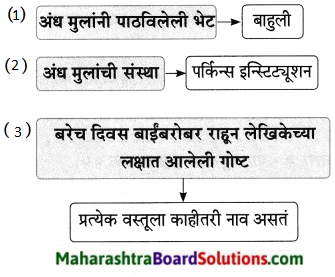
प्रश्न 2.
सहसंबंध लिहा.
1. मायेची: पाखर :: बालसुलभ : …………..
2. हॅट : शब्द :: बसणं : ………………….
उत्तर:
1. आनंद
2. क्रियापद
उताऱ्यानुसार घटनांचा क्रम लावा.
प्रश्न 1.
- अंध मुलांनी लेखिकेला एक बाहुली दिली होती.
- बोटांच्या खेळाद्वारे लेखिका शब्द व क्रियापदं शिकली.
- दुसऱ्या दिवशी सकाळीच बाई लिखिकेला आपल्या खोलीत घेऊन गेल्या.
- बाईंनी लेखिकेच्या हातावर स्वत:च्या बोटांनी अक्षरं जुळवली.
उत्तर:
- दुसऱ्या दिवशी सकाळीच बाई लिखिकेला आपल्या खोलीत घेऊन गेल्या.
- अंध मुलांनी लेखिकेला एक बाहुली दिला होती.
- बाईंनी लेखिकेच्या हातावर स्वत:च्या बोटांनी अक्षरं जुळवली.
- बोटांच्या खेळाद्वारे लेखिका शब्द व क्रियापदं शिकली.
खालील प्रश्नांची उत्तरे एका वाक्यात लिहा.
प्रश्न 1.
बाहुली कोणी सजवली होती?
उत्तर:
बाहुली लॉरा ब्रिजमननं सजवली होती.

प्रश्न 2.
लेखिकेच्या बाई शिकविण्याबरोबरच काय करायला आल्या होत्या?
उत्तर:
लेखिकेच्या बाई शिकविण्याबरोबर लेखिकेवर मायेची पाखर घालायला आल्या होत्या.
प्रश्न 3.
लेखिकेला कोणता खेळ आवडला?
उत्तरः
लेखिकेला बोटांचा खेळ खूप आवडला.
प्रश्न 4.
कंसातील योग्य शब्द वापरून रिकाम्या जागा भरा.
- ………. हा बोटांचा खेळ मला फार आवडला. (P-I-N, m-u-q, d-O-1-1, W-A-T-E-R)
- त्याहीपेक्षा जास्त माझ्यावर ………… पाखर घालायला. (मायेची, प्रेमाची, अभिमानाची, आनंदाची)
- धावतच …………. उतरून मी आईपाशी गेले! (घाट, शिडी, पायरी, जिना)
- मी फक्त बोटांनी बाईंचं ………….’ करत होते. (अंधानुकरण, चित्रीकरण, अनुकरण, छायाचित्र)
उत्तर:
- d-O-1-1
- मायेची
- जिना
- अनुकरण
कृती 2: आकलन कृती
योग्य पर्याय निवडून विधाने पूर्ण करा.
प्रश्न 1.
त्या मला शिकवायला आल्या होत्या, ……………..
(अ) त्याहीपेक्षा जास्त माझ्यावर ममतेची पाखर घालायला!
(ब) त्याहीपेक्षा जास्त माझ्यावर प्रेमाची पाखर घालायला!
(क) त्याहीपेक्षा जास्त माझ्यावर मायेची पाखर घालायला!
(ड) त्याहीपेक्षा जास्त माझ्यावर आनंदाची पाखर घालायला!
उत्तरः
त्या मला शिकवायला आल्या होत्या, त्याहीपेक्षा जास्त माझ्यावर मायेची पाखर घालायला!

प्रश्न 2.
शेवटी जेव्हा एकदा मी ती अक्षरं बरोबर काढली तेव्हा ………………
(अ) बालसुलभ अभिमान आणि आनंदानं फुलून आले.
(ब) बालसुलभ आनंद आणि अभिमानानं फुलून आले.
(क) बालसुलभ आनंद आणि अभिमानानं हळूहळू फुलून आले.
(ड) बालसुलभ आनंद आणि अभिमानानं अचानक फुलून आले.
उत्तरः
शेवटी जेव्हा एकदा मी ती अक्षरं बरोबर काढली तेव्हा बालसुलभ आनंद आणि अभिमानानं फुलून आले.
प्रश्न 3.
आकृतिबंध पूर्ण करा.
उत्तरः
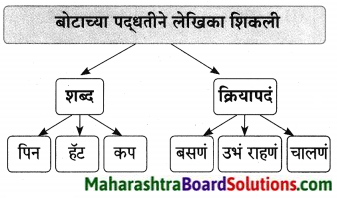
प्रश्न 4.
कोण ते लिहा.
उत्तरः

प्रश्न 1.
परिच्छेदावरून सत्य वा असत्य ते लिहा.
- लेखिकेला बोटांचा खेळ खूपच आवडला.
- बाहुली अनी सुलिव्हॅनने सजवली.
- लेखिका धावतच जिना उतरून बाईंपाशी आली.
- प्रत्येक वस्तूला काहीतरी नाव असतं, हे लेखिकेच्या लक्षातं आलं.
उत्तर:
- सत्य
- असत्य
- असत्य
- सत्य

कृती 3: व्याकरण कृती
प्रश्न 1.
खालील वाक्य लेखननियमांनुसार शुद्ध करून लिहा.
माझ्या जवल कुणितरि येतयसं मला जाणवलं.
उत्तरः
माझ्या जवळ कुणीतरी येतयसं मला जाणवलं.
प्रश्न 2.
उताऱ्यातील शब्दांच्या जाती शोधून लिहा.
उत्तरः
- नामे: बाई, हात, आई, बोटं
- सर्वनामे: मी, माझ्या, मला
- विशेषणे: मायेची, दुसऱ्या, अंध
- शब्दयोगी अव्यय: आईपाशी, तिच्यासमोर, बाईबरोबर
प्रश्न 3.
अचूक शब्द लिहा.
1. सुलिव्हॅन, सूलिव्हॅन, सुलीव्हॅन, सूलीव्हॅन
2. इन्स्टिट्युशन, इन्स्टिट्यूशन, इनसिस्टूशन, इनस्टूक्षण
उत्तर:
1. सुलिव्हॅन
2. इन्स्टिट्यूशन
प्रश्न 4.
लिंग बदला.
उत्तर:
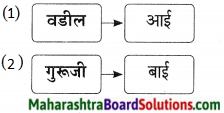
प्रश्न 5.
समानार्थी शब्दांच्या जोड्या लावा.
| ‘अ’ गट |
‘ब’ गट |
| 1. बाई |
(अ) माता |
| 2. आई |
(ब) हात |
| 3. कर |
(क) आनंद |
| 4. हर्ष |
(ड) शिक्षिका |
उत्तर:
| ‘अ’ गट |
‘ब’ गट |
| 1. बाई |
(ड) शिक्षिका |
| 2. आई |
(अ) माता |
| 3. कर |
(ब) हात |
| 4. हर्ष |
(क) आनंद |

प्रश्न 6.
विरुद्धार्थी शब्द लिहा.
1. डोळस ×
2. चढणे ×
उत्तर:
1. अंध
2. उतरणे
प्रश्न 7.
उताऱ्यातील दोन अनेकवचनी शब्द शोधून लिहा.
उत्तर:
1. बोटांनी
2. मुलांनी
प्रश्न 8.
तक्ता पूर्ण करा.
उत्तर:
| शब्द |
प्रत्यय |
विभक्ती |
| सकाळीच |
च |
षष्ठी (एकवचन) |
| खोलीत |
त |
सप्तमी (एकवचन) |
| वस्तूला |
ला |
द्वितीया (एकवचन) |
| बोटांनी |
नी |
तृतीया (अनेकवचन) मूळ |
प्रश्न 9.
तक्ता पूर्ण करा.
उत्तर:
| शब्द |
मूळ शब्द |
सामान्यरूप |
| मुलांनी |
मुले |
मुलां |
| अभिमानानं |
अभिमान |
अभिमाना |
| बोटांनी |
बोट |
बोटां |

प्रश्न 10.
खालील वाक्यात अधोरेखित शब्दांऐवजी पाठात आलेले योग्य वाक्प्रचार शोधून वाक्य पुन्हा लिहा.
शेजारच्या काकू नेहमीच आमच्यावर प्रेम करतात.
उत्तर:
शेजारच्या काकू नेहमीच आमच्यावर मायेची पाखर घालतात.
प्रश्न 11.
वाक्यातील काळ ओळखा.
मी एक शब्द जुळवत होते.
उत्तरः
भूतकाळ
प्रश्न 12.
काळ बदला. (भविष्यकाळ करा)
प्रत्येक वस्तूला काहीतरी नाव असतं, हे माझ्या लक्षात आलं.
उत्तरः
प्रत्येक वस्तूला काहीतरी नाव असतं, हे माझ्या लक्षात येईल.
प्रश्न 13.
पर्यायी शब्द लिहा.
उत्तरः
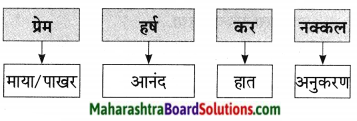
कृती 4 : स्वमत
प्रश्न 1.
’दिव्यांग मुलांना भाषाशिक्षणात येणारे संभाव्य अडथळे’ यावर तुमचे मत लिहा.
उत्तरः
दिव्यांग मुले ही विशेषकरून मुकी, बहिरी व अंध असतात. त्यामुळे त्यांना शिकविणे ही एक प्रकारे तारेवरची कसरतच असते. त्यांना शिक्षण घेताना विविध अडचणी येत असतात. एकतर प्रत्यक्ष वस्तू पाहण्यासाठी त्यांच्याकडे दृष्टी नसते, त्यामुळे त्यांना दृष्टीच्या रूपातून प्रत्यक्ष अनुभव उपलब्ध करून देणे सहज शक्य नसते. अशा वेळी त्यांना शिकविताना स्पर्शाच्या माध्यमातून प्रत्यक्ष अनुभव देणे आवश्यक असते. स्वत: दिव्यांग मुलांनाही भाषेचे ज्ञान प्राप्त करून घेताना अशा प्रकारच्या प्रत्यक्ष अनुभवांशी समायोजन साधावे लागते. त्यांना भाषाशिक्षण प्राप्त करून घेण्यासाठी अथक प्रयत्न करावे लागतात. ते हळूहळू शब्द शिकत असतात. त्यांची सर्वसामान्य मुलांपेक्षा ज्ञान प्राप्त करून घेण्याची गती कमी असते.

पुढील उताऱ्याच्या आधारे दिलेल्या सूचनेनुसार कृती कराः:
कृती 1 : आकलन कृती
प्रश्न 1.
आकृतिबंध पूर्ण करा.
उत्तरः
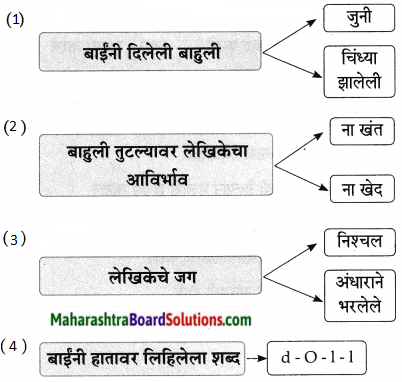
खालील प्रश्नांची उत्तरे एका वाक्यात लिहा.
प्रश्न 1.
बाईंनी लेखिकेच्या मांडीवर ठेवलेली बाहुली कशी होती?
उत्तर:
बाईंनी लेखिकेच्या मांडीवर ठेवलेली बाहुली जुनी, चिंध्या झालेली होती.
प्रश्न 2.
लेखिकेला केव्हा उकळ्या फुटू लागल्या?
उत्तर:
बाहुलीचे तुकडे होऊन आपल्या पायांशी पडलेले जाणवल्यानंतर लेखिकेला उकळ्या फुटू लागल्या.
प्रश्न 3.
लिखिकेच्या निश्चल आणि अंधाऱ्या जगात कोणत्या भावना उगवणे कठिण होते?
उत्तर:
लेखिकेच्या निश्चल आणि अंधाऱ्या जगात हळव्या व हळूवार भावना उगवणे कठिण होते.
प्रश्न 4.
बाईंनी लेखिकेच्या बाहुलीचे तुकडे कुठे लोटले?
उत्तर:
बाईंनी लेखिकेच्या बाहुलीचे तुकडे झाडून शेकोटी जवळच एका बाजूला लोटले.

कंसातील योग्य शब्द वापरून रिकाम्या जागा भरा.
प्रश्न 1.
1. एवढा थयथयाट करूनही ना खंत ना खेद असाच माझा होता. (विचार, आदरभाव, आविर्भाव, अविचार)
2. माझा हा गोंधळ बघून त्यांचा …………. झाला. (हिरमोड, थयथयाट, खेद, खंत)
उत्तर:
1. आविर्भाव
2. हिरमोड
कृती 2: आकलन कृती
योग्य पर्याय निवडून विधाने पूर्ण करा.
प्रश्न 1.
माझा हा गोंधळ बघून त्यांचा हिरमोड झाला …………….
(अ) आणि त्यांनी तो विषय तेवढ्यावर ठेवला नाही.
(ब) आणि त्यांनी तो विषय तेवढ्यावरच न ठेवता पुढे चालूच ठेवला.
(क) आणि त्यांनी तो विषय तेवढ्यावरच ठेवला.
(ड) आणि त्यांनी तो विषय तेवढ्यावर आटपून घेतला.
उत्तर:
माझा हा गोंधळ बघून त्यांचा हिरमोड झाला आणि त्यांनी तो विषय तेवढ्यावरच ठेवला.
प्रश्न 2.
त्या बाहुलीचे तुकडे होऊन माझ्या पायांशी पडलेले …………
(अ) मला जाणवल्यावर मला उकळ्या फुटू लागल्या.
(ब) मला जाणवल्यावर मला आनंदानी उकळ्या फुटू लागल्या.
(क) मला जाणवल्यावर मला रागाच्या उकळ्या फुटू लागल्या.
(ड) मला जाणवल्यावर मला नकळत उकळ्या फुटू लागल्या.
उत्तरः
त्या बाहुलीचे तुकडे होऊन माझ्या पायांशी पडलेले मला जाणवल्यावर मला उकळ्या फुटू लागल्या.
प्रश्न 3.
कोण ते लिहा.
उत्तरः
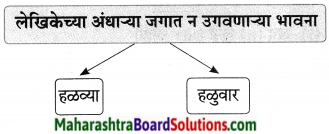
प्रश्न 4.
सत्य वा असत्य ते लिहा.
- बाईंनी लेखिकेची जुनी चिंध्या झालेली बाहुली लेखिकेच्या मांडीवर ठेवली.
- लेखिकेचा गोंधळ बघून बाईंचा हिरमोड झाला नाही.
- लेखिकेची डोकेदुखी गेल्यानं लेखिकेलाच हायसं वाटलं.
उत्तर:
- सत्य
- असत्य
- सत्य

कृती 3 : व्याकरण कृती
खालील वाक्ये लेखननियमांनुसार शुद्ध करून लिहा.
प्रश्न 1.
आता पून्हा बाहुलीवरून त्यांचं शीकवणं सुरू झालं होतं.
उत्तरः
आता पुन्हा बाहुलीवरून त्यांचं शिकवणं सुरू झालं होतं.
प्रश्न 2.
मि माझी नवी बाहुली हिसकावून जमीनिवर आपटली.
उत्तरः
मी माझी नवी बाहुली हिसकावून जमिनीवर आपटली.
प्रश्न 3.
उताऱ्यातील दोन सर्वनामे शोधून लिहा.
उत्तर:
- मी
- माझी
- त्यांनी
- तो
- हे
- ते
- माझ्या
- मला
प्रश्न 4.
अचूक शब्द लिहा.
आवीर्भाव, आविर्भाव, आविभाव, आविभाव
उत्तरः
आविर्भाव

प्रश्न 5.
समानार्थी शब्द लिहा.
- त्रास - [ ]
- दुःख - [ ]
- गलका - [ ]
उत्तर:
- पीडा
- खेद
- गोंधळ
प्रश्न 6.
अधोरेखित शब्दाचा समानार्थी शब्द लिहून वाक्य पुन्हा लिहा.
वाटलं, बर झालं, एकदाचा त्रास गेला.
उत्तरः
वाटलं, बरं झालं, एकदाची पीडा गेली.
प्रश्न 7.
विरुद्धार्थी शब्द लिहा.
- आनंद × [ ]
- नवी × [ ]
- नंतर × [ ]
उत्तर:
- खेद
- जुनी
- आधी
प्रश्न 8.
उताऱ्यातील दोन अनेकवचनी शब्द शोधून लिहा.
उत्तर:
1. बाहुल्यांना
2. तुकडे

प्रश्न 9.
तक्ता पूर्ण करा.
उत्तर:
| शब्द |
प्रत्यय |
विभक्ती |
| बाहुलीशी |
शी |
तृतीया (एकवचन) |
| बाईंनी |
नी |
तृतीया (अनेकवचन) |
| बाहुलीचे |
चे |
षष्ठी (एकवचन) |
प्रश्न 10.
तक्ता पूर्ण करा.
उत्तर:
| शब्द |
सामान्यरूप |
| बाहुलीशी |
बाहुली |
| बाहुल्यांना |
बाहुल्यां |
प्रश्न 11.
वाक्प्रचार व अर्थ यांच्या योग्य जोड्या जुळवा.
| ’अ’ गट |
‘ब’ गट |
| 1 .खाणाखुणा करणे |
(अ) दुःख नसणे |
| 2. हिसकावणे |
(ब) खूप आनंद होणे |
| 3. उकळ्या फुटणे |
(क) इशारा करणे |
| 4. खंत नसणे |
(ड) खेचून घेणे |
प्रश्न 12.
वाक्यातील काळ ओळखा.
माझी डोकेदुखी गेल्यानं मलाही हायसं वाटलं.
उत्तर:
भूतकाळ
प्रश्न 13.
काळ बदला. (वर्तमानकाळ करा)
ती बाहुली माझी नावडती होती.
उत्तरः
ती बाहुली माझी नावडती आहे.

कृती 4 : स्वमत
प्रश्न 1.
‘अनी सुलिव्हॅन नसत्या तर हेलन घडली नसती’ या विधानाची सत्यता पटवून या.
उत्तरः
हेलन केलर ही मुळातच दिव्यांग मुलगी होती. त्यामुळे तिच्या शिक्षणात बऱ्याच अडचणी येत होत्या. तिला साधी अक्षर, शब्द ओळखही करणे अतिशय कठीण होते. त्यामुळे तिला एक असा शिक्षक हवा होता की, जो तिच्या शारीरिक दुर्बलतेला समजून तिची शिक्षणात मदत करेल. ॲनी मन्सफिल्ड सुलिव्हॅन या अशाच शिक्षिका तिला लाभल्या होत्या. अनी सुलिव्हॅन यांनी सर्वप्रथम तिच्यावर आपल्या मायेची पाखर घातली. शिकविताना तिच्या आवडीनुसार तिच्या कलानुसार घेत घेत तिला शिकविले.
हेलनचा शिक्षणात जेव्हा जेव्हा गोंधळ व्हायचा तेव्हा तेव्हा बाई संयम बाळगायच्या. हेलनची शिक्षणातील दुर्बलता लक्षात घेऊन बाईनी केवळ अक्षर, शब्द ओळख करून न देता त्यांच्या अर्थाची ही ओळख करून दिली. बाहुली, पाणी यांच्या प्रत्यक्ष अनुभवाद्वारे अर्थ समजून देण्याचा प्रयत्न केला. परिणामी हेलनच्या अंधाराने भरलेल्या आयुष्यात नवीन भवितव्याची पालवी फुटली केवळ बाईंमुळेच. म्हणून ’अॅनी सुलिव्हॅन नसत्या तर हेलन घडली नसती’ हे वाक्य सत्य वाटते.
पुढील उताऱ्याच्या आधारे दिलेल्या सूचनेनुसार कृती करा:
कृती 1 : आकलन कृती
प्रश्न 1.
आकृतिबंध पूर्ण करा.
उत्तरः
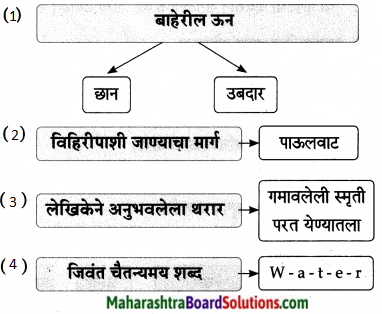
प्रश्न 2.
उताऱ्यानुसार घटनांचा क्रम लावा.
- एका चैतन्यमय जिवंत शब्दानं लेखिकेच्या आत्म्याला जशी जाग आली.
- उन्हात जायला मिळणार या विचाराने लेखिका टुणटुण उड्या मारू लागली.
- गमावलेली स्मृती परत येण्याचा थरार लेखिकेने अनुभवला.
- फुलांचा सुगंध दरवळत होता.
उत्तर:
- उन्हात जायला मिळणार या विचाराने लेखिका टुणटुण उड्या मारू लागली.
- फुलांचा सुगंध दरवळत होता.
- गमावलेली स्मृती परत येण्याचाथरार लेखिकेने अनुभवला.
- एका चैतन्यमय जिवंत शब्दानं लेखिकेच्या आत्म्याला जशी जाग आली.

खालील प्रश्नांची उत्तरे एका वाक्यात लिहा.
प्रश्न 1.
लेखिका आनंदानं टुणटुण उड्या का मारू लागली?
उत्तर:
बाहेर छान उबदार उन्हात जायला मिळणार या विचारानं लेखिका आनंदानं टुणटुण उड्या मारू लागली.
प्रश्न 2.
लेखिका व बाई विहिरीपाशी कशा पोहोचल्या?
उत्तर:
पाऊलवाटेनं जात लेखिका व बाई विहिरीपाशी पोहोचल्या.
कंसातील योग्य शब्द रिकाम्या जागी भरा.
प्रश्न 1.
1. त्यांच्या फुलांचा सुगंध ……….होता. (भावलेला, पसरलेला, दरवळत, आवडलेला)
2. मी एकदम …………”उभी राहिले. (स्तब्ध, निश्चल, शांत, निशब्द)
उत्तर:
1. दरवळत
2. निश्चल
सहसंबंध लिहा.
प्रश्न 1.
1. सुंगंधी : फुले :: उबदार : ……………………
2. स्पष्ट : अस्पष्ट :: मृत : ……………………
उत्तर:
1. उन्ह
2. जिवंत
कृती 2 : आकलन कृती
प्रश्न 1.
योग्य पर्याय निवडून विधान पूर्ण करा.
बाईंनी माझी हॅट माझ्या हातात ठेवल्यावर मी ओळखलं ….………………
(अ) आता बाहेर, पावसात जायचंय.
(ब) आता बाहेर, तप्त उन्हात जायचंय.
(क) आता बाहेर, छान उबदार उन्हात जायचंय.
(ख) आता बाहेर, थंडीत जायचंय.
उत्तर:
बाईंनी माझी हॅट माझ्या हातात ठेवल्यावर मी ओळखलं आता बाहेर, छान उबदार उन्हात जायचंय.

प्रश्न 2.
कोण ते लिहा.
उत्तर:

प्रश्न 3.
कारणे दया.
उत्तर:

चूक की बरोबर ते लिहा.
प्रश्न 1.
1. त्यांच्या फुलांचा दुर्गंध दरवळत होता.
2. पाऊलवाटेनं जात लेखिका व बाई विहिरीपाशी आल्या.
उत्तर:
1. चूक
2. बरोबर
कृती 3 : व्याकरण कृती
प्रश्न 1.
खालील वाक्य लेखननियमांनुसार शुद्ध करून लिहा.
पण लोकरच ते दुर होणार होते.
उत्तर:
पण लौकरच ते दूर होणार होते.

प्रश्न 2.
उताऱ्यातील दोन विशेषणे शोधून लिहा.
उत्तर:
- छान
- उबदार
- वेलीच्या
- थंडगार
- इतके
- गमावलेली
- जिवंत
- चैतन्यमय
प्रश्न 3.
अचूक शब्द लिहा.
1. निश्चल, नीश्चल, निचल, निश्चल
2. चेतन्यमय, चैतनमय, चैतन्यमय, चेतनमय
उत्तर:
1. निश्चल
2. चैतन्यमय
प्रश्न 4.
समानार्थी शब्द लिहा.
- मार्ग - [ ]
- जल - [ ]
- आठवण - [ ]
- उजेड - [ ]
उत्तर:
- वाट
- पाणी
- स्मृती
- प्रकाश
प्रश्न 5.
विरुद्धार्थी शब्द लिहा.
- आत ×
- जलद ×
- रात्र ×
- जवळ ×
उत्तर:
- बाहेर
- सावकाश
- दिवस
- दूर

प्रश्न 6.
अधोरेखित शब्दाचा विरुद्धार्थी शब्द लिहून वाक्य पुन्हा लिहा.
इतके दिवस आपण काहीतरी विसरून गेलो हातो, याची स्पष्ट जाणीव झाली.
उत्तरः
इतके दिवस आपण काहीतरी विसरून गेलो होतो, याची अस्पष्ट जाणीव झाली.
प्रश्न 7.
उताऱ्यातील दोन अनेकवचनी शब्द शोधून लिहा.
उत्तर:
- जाळ्या
- फुलांचा
- बोटांनी
प्रश्न 8.
तक्ता पूर्ण करा.
उत्तर:
| शब्द |
प्रत्यय |
विभक्ती |
| बाईंनी |
नी |
तृतीया (अनेकवचन) |
| वेलीच्या |
च्या |
षष्ठी (एकवचन) |
| धारेत |
त |
सप्तमी (एकवचन) |
| पाण्याच्या |
च्या |
षष्ठी (एकवचन) |
प्रश्न 9.
तक्ता पूर्ण करा.
उत्तर:
| शब्द |
मूळ शब्द |
सामान्यरूप |
| आत्म्याला |
आत्मा |
आत्म्या |
| फुलांचा |
फूले |
फुलां |
| वेलीच्या |
वेल |
वेली |
| वाटेत |
वाट |
वाटे |

प्रश्न 10.
कंसातील वाक्प्रचारांचा अर्थ लिहून वाक्यात उपयोग करा. (निश्चल उभे राहणे, आनंदाची उधळण करणे)
उत्तर:
1. निश्चल उभे राहणे - स्तब्ध उभे राहणे
वाक्य: बाबा रागावले आहेत हे ओळखून सीमा त्यांच्यासमोर निश्चल उभी राहिली.
उत्तर:
2. आनंदाची उधळण करणे - आनंद पसरवणे
वाक्यः त्या पहिल्या पावसाने सगळीकडे आनंदाची उधळण केली होती.
प्रश्न 11.
वाक्यातील काळ ओळखा.
अजूनही तसे ह्या वाटेत बरेच अडथळे होते.
उत्तरः
भूतकाळ
प्रश्न 12.
काळ बदला. (भविष्यकाळ करा)
त्यांच्या फुलांचा सुगंध दरवळत होता.
उत्तरः
त्यांच्या फुलांचा सुगंध दरवळेल.
प्रश्न 13.
पर्यायी शब्द लिहा.
उत्तरः

कृती 4 : स्वमत
प्रश्न 1.
‘सर्वसामान्य मुलांबरोबर दिव्यांग मुलांना शिक्षणाची समान संधी द्यायला हवी’ या विचाराचे सामाजिक महत्त्व जाणा व ते शब्दबद्ध करा.
उत्तर:
निसर्गनियमानुसार तसेच कायद्यानुसार प्रत्येकाला शिक्षणाचा समान अधिकार आहे. त्यामुळे सर्वसामान्य मुले किंवा दिव्यांग मुले हा भेदभाव आपण करू शकत नाही. पण तसे झाल्यास दिव्यांग मुले ही त्यांच्या प्राथमिक हक्कापासून वंचित होतील, त्यांच्यामध्ये न्यूनगंडाची, स्वत:मध्ये काहीतरी कमतरता आहे ही भावना निर्माण होईल. परिणामी समाजातील एक महत्त्वाचा घटक समाजापासून दूर होईल, त्यामुळे दिव्यांग मुलांना शिक्षणाची समान संधी द्यायला हवी. शिक्षणामुळे त्यांच्यातील न्यूनगंड कमी होऊन ते आपल्या, दिव्यंगावर मात करतील व ते स्वावलंबी बनतील. त्यांच्यामध्ये शिक्षणामुळे स्वाभिमान जागृत होईल. शिक्षणामुळे त्यांना समाजात मानाचे स्थान मिळेल. परिणामी समाजाची, देशाची प्रगती होण्यास मोठी मदत मिळेल. त्यामुळेच सर्वसामान्य मुलांबरोबर दिव्यांग मुलांना शिक्षणाची समान संधी द्यायला हवी.

पुढील उताऱ्याच्या आधारे दिलेल्या सूचनेनुसार कृती कराः
कृती 1 : आकलन कृती
प्रश्न 1.
आकृतिबंध पूर्ण करा.
उत्तर:
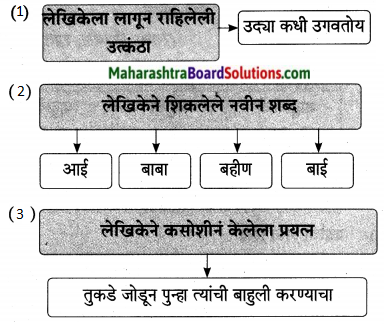
प्रश्न 2.
कारणे दया.
उत्तर:
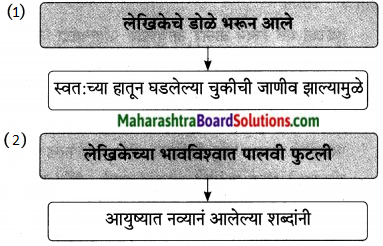
प्रश्न 3.
उताऱ्यानुसार वाक्यांचा क्रम लावा.
- आयुष्यात पहिल्यांदाच मला उदया कधी उगवतोय ह्याची उत्कंठा लागून राहिली होती.
- दारापाशी आल्यावर मला मी मोडलेल्या बाहुलीची आठवण आली.
- मला जशी एक वेगळीच नवी दृष्टी मिळाली होती.
- तो दिवस माझ्या दृष्टीनं फार नाट्यमय होता.
उत्तर:
- मला जशी एक वेगळीच नवी दृष्टी मिळाली होती.
- दारापाशी आल्यावर मला मी मोडलेल्या बाहुलीची आठवण झाली.
- तो दिवस माझ्या दृष्टीनं फार नाट्यमय होता.
- आयुष्यात पहिल्यांदाच मला उदया कधी उगवतोय ह्याची उत्कंठा लागून राहिली होती.

खालील प्रश्नांची उत्तरे एका वाक्यात लिहा.
प्रश्न 1.
लेखिकेचे मन कोणत्या गोष्टींसाठी आतुर झाले होते?
उत्तर:
लेखिकेचे मन नवीन गोष्टी शिकण्यासाठी आतुर झाले होते.
प्रश्न 2.
दारापाशी आल्यावर लेखिकेला कशाची आठवण आली?
उत्तरः
दारापाशी आल्यावर लेखिकेला तिनेच मोडलेल्या बाहुलीची आठवण आली.
प्रश्न 3.
लेखिकेला कोणती उत्कंठा लागून राहिली होती?
उत्तरः
लेखिकेला आयुष्यात पहिल्यांदाच उदया कधी उगवतोय याची उत्कंठा लागून राहिली होती.
कंसातील योग्य शब्द वापरून रिकाम्या जागा भरा.
प्रश्न 1.
1. आयुष्यात नव्यानं आलेल्या या शब्दांनी माझ्या ….……….. पालवी फुटली. (भावविश्वात, विश्वात, जगात, आयुष्यात)
2. तो दिवस माझ्या दृष्टीनं फार ……….. होता. (आनंददायी, चैतन्यमय, नाट्यमय, पश्चात्तापाचा)
उत्तर:
1. भावविश्वात
2. नाट्यमय
प्रश्न 2.
सहसंबंध लिहा.
नवीन : गोष्टी :: नवा : …………………
उत्तरः
विचार

कृती 2 : आकलन कृती
योग्य पर्याय निवडून विधाने पूर्ण करा.
प्रश्न 1.
आता प्रत्येक गोष्टीला नाव होतं ……
(अ) आणि प्रत्येक नावातून उमलत होता एकेक नवा विचार!
(ब) आणि उमलत होता एकेक नवा विचार प्रत्येक नावातून !
(क) आणि नावा-नावातून उमलत होता एकेक नवा विचार!
(ड) आणि एकेक नवा विचार उमलत होता प्रत्येक नावातून !
उत्तरः
आता प्रत्येक गोष्टीला नाव होतं आणि नावा-नावातून उमलत होता एकेक नवा विचार!
प्रश्न 2.
चाचपडत शेकोटीजवळ लोटलेले बाहुलीचे …….…………… .
(अ) तुकडे गोळा करून मी उचलले.
(ब) मी तुकडे गोळा करून उचलले.
(क) तुकडे गोळा करून मी उचलले.
(ड) तुकडे मी गोळा करून उचलले.
उत्तरः
चाचपडत शेकोटीजवळ लोटलेले बाहुलीचे तुकडे मी गोळा करून उचलले.
प्रश्न 3.
कोण ते लिहा.
उत्तरः

चूक वा बरोबर ते लिहा.
प्रश्न 1.
- लेखिकेचे मन नवीन गोष्टी शिकण्यासाठी आतुर झालं होतं.
- लेखिकेला आज जशी एक वेगळीच नवी दृष्टी मिळाली नव्हती.
- दारापाशी आल्यावर लेखिका मोडलेल्या बाहुलीची आठवण विसरली.
उत्तर:
- बरोबर
- चूक
- चूक

कृती 3 : व्याकरण कृती
प्रश्न 1.
खालील वाक्य लेखननियमांनुसार शुद्ध करून लिहा.
त्याच दिवशी मी खुप नवे शब्द शिकुन घेतले.
उत्तरः
त्याच दिवशी मी खूप नवे शब्द शिकून घेतले.
प्रश्न 2.
उताऱ्यातील दोन नामे शोधून लिहा.
उत्तरः
- विहीर
- बाहुली
- डोळे
- शब्द
- आई
- बाबा
- बहीण
- बाबा
- रात्र
- पलंग
प्रश्न 3.
अचूक शब्द लिहा.
1. कशोशीनं, कसोशिनं, कशोशिनं, कसोशीनं
2. पच्चात्ताप, पश्चाताप, पश्चात्ताप, पश्चत्ताप
उत्तर:
1. कसोशीनं
2. पश्चात्ताप
प्रश्न 4.
समानार्थी शब्द लिहा.
- नयन - [ ]
- रजनी - [ ]
- नजर - [ ]
- मेहनत - [ ]
उत्तर:
- डोळा
- रात्र
- दृष्टी
- प्रयत्न

प्रश्न 5.
विरुद्धार्थी शब्द लिहा.
- जुने ×
- विस्मरण ×
- बरोबर ×
- अनिश्चित ×
उत्तर:
- नवीन
- आठवण
- चूक
- निश्चित
प्रश्न 6.
उताऱ्यातील दोन अनेकवचनी शब्द शोधून लिहा.
उत्तर:
- तुकडे
- डोळे
- नवे
- शब्द
- आठवणी
प्रश्न 7.
तक्ता पूर्ण करा.
उत्तर:
| शब्द |
प्रत्यय |
विभक्ती |
| गोष्टीला |
ला |
द्वितीया (एकवचन) |
| शब्दांनी |
नी |
तृतीया (अनेकवचन) |
| बाहुलीचे |
चे |
षष्ठी (एकवचन) |
| नावातून |
न |
पंचमी (एकवचन) |

प्रश्न 8.
तक्ता पूर्ण करा.
उत्तर:
| शब्द |
मूळ शब्द |
सामान्यरूप |
| बाहुलीची |
बाहुली |
बाहुली |
| गोष्टीला |
गोष्ट |
गोष्टी |
| अर्थात |
अर्थ |
अर्था |
| शब्दांनी |
शब्द |
शब्दां |
प्रश्न 9.
पर्यायी शब्द लिहा.
उत्तर:

कृती 4 : स्वमत
प्रश्न 1.
तुमच्या मते हेलन केलर आयुष्यात पहिल्यांदा ’उदयाची’ वाट का पाहत असेल?
उत्तरः
हेलन केलर ही एक दिव्यांग मुलगी होती. आंधळेपणा, बहिरेपणा व मुकेपणा यामुळे तिच्या संपूर्ण आयुष्यात अंधार पसरलेला होता. परंतु शिक्षिका अनी मॅन्सफिल्ड सुलिव्हन यांच्यामुळे तिला शब्दांची ओळख झाली. नवीन शब्द कळू लागले. परिचित अपरिचित वस्तूंची नावे तिला कळू लागली, त्यामुळे अंधाराने भरलेल्या तिच्या जगामध्ये नवचैतन्य निर्माण झाले. त्यामुळेच हेलनच्या आयुष्यात नव्यानं आलेल्या या शब्दांनी तिच्या भावविश्वात पालवी फुटली. अंधाराने भरलेल्या आयुष्यात जे घडले नव्हते ते घडले. या सर्व कारणांमुळे हेलन केलर आयुष्यात पहिल्यांदा ’उदयाची’ वाट पाहत असेल असे वाटते.
शब्दांचा खेळ Summary in Marathi
लेखकाचा परिचय:
नाव: हेलन केलर
कालावधी: (1880-1968)
परिचय: विसाव्या शतकावर आपल्या अलौकिक कार्याने आणि व्यक्तिमत्त्वामुळे ज्या लोकोत्तर व्यक्तींचा प्रभाव पडला, त्यामध्ये हेलन केलर यांचे नाव अग्रगण्य आहे. अंधत्व, मुकेपणा आणि बधिरत्व अशा तिहेरी अपंगत्वाशी सामना देत त्यांनी आपले शिक्षण पूर्ण केले. अंधारातून प्रकाशाकडे नेणाऱ्या हेलन केलर यांच्या शिक्षणाच्या थक्क करणाऱ्या अनुभवांनी युक्त अशा ’the story of my life’ या आत्मकथनाचा मराठी अनुवाद श्री. माधव कर्वे यांनी ’माझी जीवनकहाणी’ या पुस्तकरूपाने केला आहे.
प्रस्तुत उतारा ’माझी जीवनकहाणी - हेलन केलर, अनुवाद - माधव कर्वे, या पुस्तकातून घेतला आहे.

प्रस्तावना:
‘शब्दांचा खेळ’ हा उतारा श्री माधव कर्वे यांनी लिहिलेल्या हेलन केलर यांच्या आत्मवृत्ताच्या अनुवादातून घेतला आहे. या पाठात हेलन केलर यांना अपंगत्वामुळे भाषा शिक्षणात येणारे अडथळे व हे अडथळे दूर करण्यासाठी त्यांनी व त्यांच्या शिक्षिकेने केलेले प्रयत्न याचे वर्णन येथे केले आहे.
The extract ’Shabdancha Khel’ is taken from the translation of the autobiography of Helen Keller. Helen Keller became deaf and blind at the age of 19 months. This extract tells us about the extraordinary and remarkable struggle of Helen and her teacher, to overcome her shortcomings in learning language.
शब्दार्थ:
- नवल - आश्चर्य (wonder)
- पोर्च - द्वारमंडप (porch)
- अपेक्षा - इच्छा (ambition , wish)
- खाणाखुणा - येचे अर्थ खुणा, इशारा (signs, marks)
- लगबग - घाई व गडबड (hurry, hustle)
- अंदाज - सुमार, अदमास (rough estimate)
- कडवटपणा - कडूपणा (bitterness)
- व्यग्र - व्यस्त, गुंग (engrossed)
- झगडा - भांडण (dispute)
- दाट - घन (thick, dense)
- स्पर्श - संपर्क (touch)
- किनारा - काठ (a bank)
- ताण - दबाव (strain, tension)
- नि:शब्द - काही न बोलता, शांत (silent)
- आक्रंदन - तीव्र शोक, आक्रोश (wailing)
- न्हाणे - नाहणे, स्नान करणे (to bathe)
- पाखर - येथे अर्थ सावली (shade)
- जिना - पायऱ्या (staircase)
- चिंध्या - फाटलेले वस्त्र (strips of clothes)
- तानमान - स्थलकाल, परिस्थितीची अनुकूल संधी
- हिसकावणे - खेचून घेणे (to take away forcibly)
- पीडा - त्रास, वेदना (trouble, pain)
- खंत - दु:ख (regret)
- खेद - दु:ख (regret)
- आविर्भाव - हावभाव (expression)
- निश्चल - स्तब्ध, अढळ (stable, firm, still)
- हळवे - नाजूक (sentimental)
- उबदार - गरम करणारे (warm)
- टुणटुण - लहान-लहान उड्या मारत (hoppingly)
- पाऊलवाट - पायवाट (path)
- दरवळत - सर्वत्र पसरत
- धारा - प्रवाह (flow)
- ओघळ - बारीक प्रवाह (streamlet)
- अस्पष्ट - स्पष्ट नसलेले (unclear)
- जाणीव - आकलन, बोध (realization)
- स्मृती - आठवण (memory)
- थरार - (thrill)
- उसळणे - वर जाणे (to rise up)
- चैतन्यमय - उत्साही (enthusiastic)
- उधळणे - येचे अर्थ उडवणे (to throw)
- अडथळे - अडचणी (problems, obstacles)
- चाचपडत - येथे अर्थ हातांनी स्पर्श करणे / शोधणे
- पश्चात्ताप - खेद (remorse)
- भावविश्व - भावनेतील जग
- नाट्यमय - नाट्यपूर्ण (dramatic)
- पलंग - खाट (bedstead, coach)
- शेकोटी - जाळ (a little warming fire)
टिपा:
- अनी मॅन्सफिल्ड सुलिव्हॅन - लेखिका हेलन केलर यांची शिक्षिका
- हनीसकल वेल - सुगंधी फुलांची वेल
- होकायंत्र - दिशा ओळखण्यासाठी गलबतावर वापरले जाणारे यंत्र
- पर्किन्स इन्स्टिट्यूशन - या संस्थेची स्थापना 1929 मध्ये झाली. ही अमेरिकेतील सर्वांत जुनी अंध व्यक्तींसाठी असलेली शाळा आहे.

वाक्प्रचार:
- नवल वाटणे - आश्चर्य वाटणे
- अंदाज येणे - साधारण कल्पना येणे
- कल्पना नसणे - माहित नसणे
- व्यग्र होणे - व्यस्त असणे, मग्न/गुंग असणे
- थकून जाणे - दमणे
- ताण असणे - तणाव असणे
- छाती धडधडणे - भीती वाटणे
- मायेची पाखर घालणे - प्रेम करणे
- अभिमानानं फुलून येणे - खूप आनंद होणे
- अनुकरण करणे - नक्कल करणे
- खाणाखुणा करणे - इशारा करणे
- उकळ्या फुटणे - खूप आनंद होणे
- हिसकावून घेणे - खेचून घेणे
- खंत नसणे - दु:ख नसणे
- आनंदाची उधळण करणे - आनंद पसरवणे
- आतुर होणे - उत्सुक होणे
- नवी दृष्टी मिळणे - नवीन दिशा मिळणे
- पश्चात्ताप होणे - खेद वाटणे/वाईट वाटणे/पस्तावा वाटणे
- पालवी फुटणे - नवीन उत्साह निर्माण होणे
- उत्कंठा लागणे - उत्सुकता लागणे.
- हिरमोड होणे - नाराज होणे
- कसोशीने प्रयत्न करणे - खूप कष्ट करणे
- आतुर होणे - उत्सुक होणे
9th Std Marathi Questions And Answers:
![]()
![]()
![]()
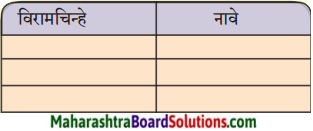
![]()
![]()
![]()


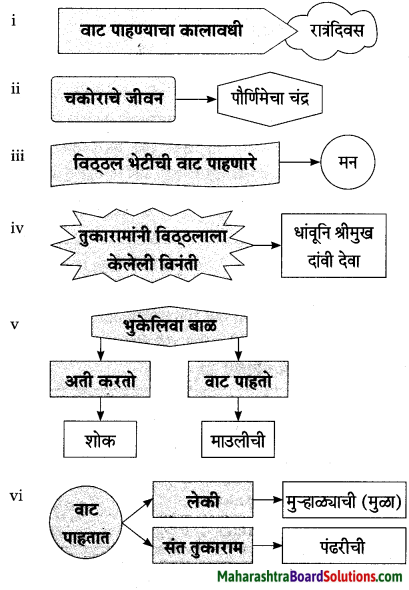

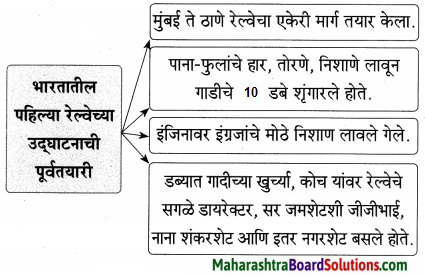

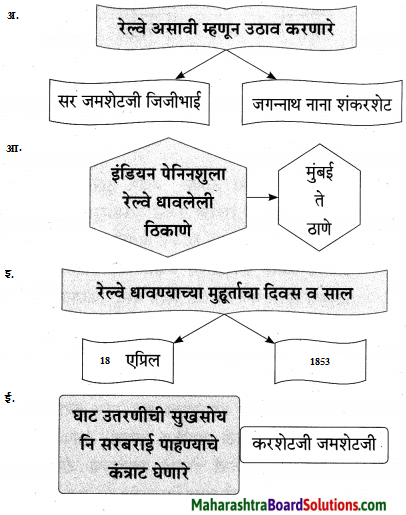

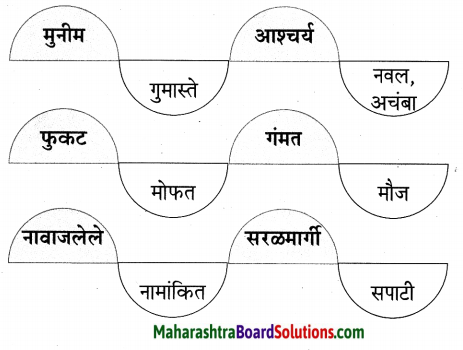
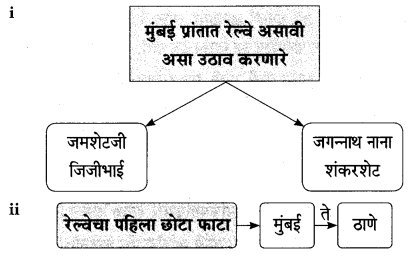
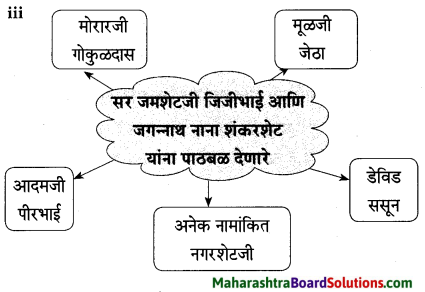
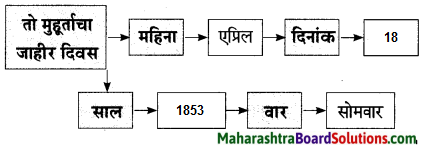

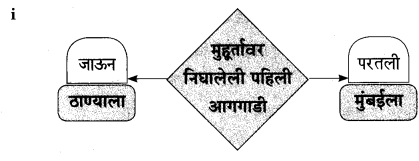
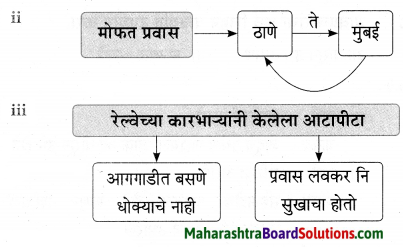
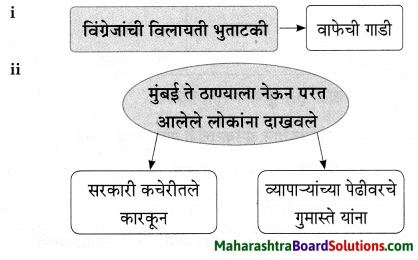
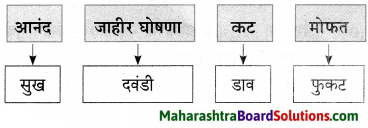

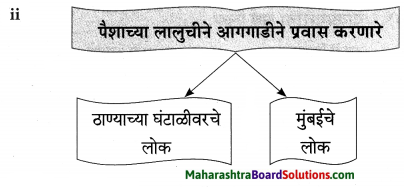
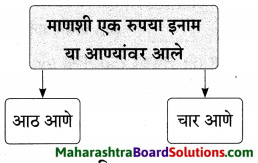

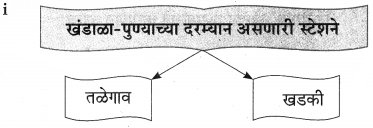

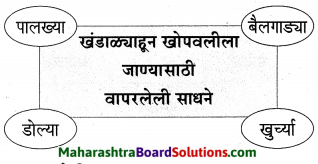




























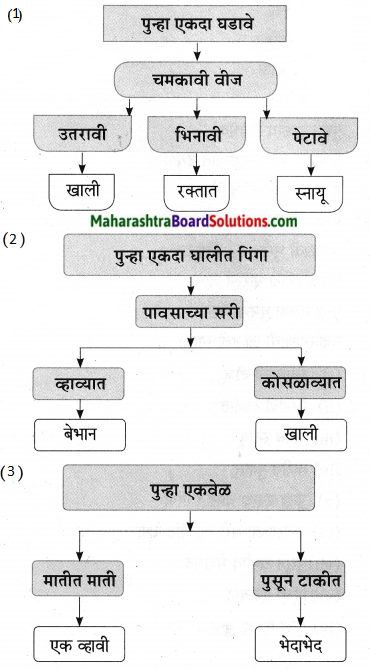
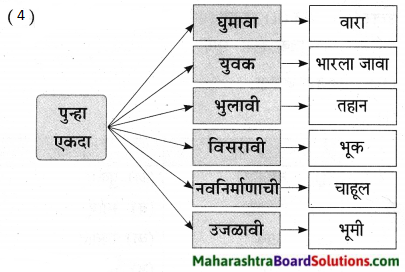

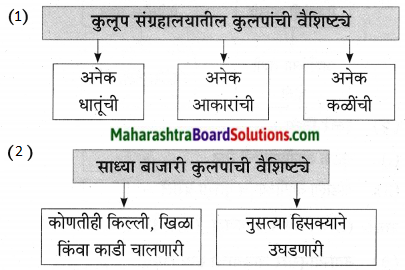


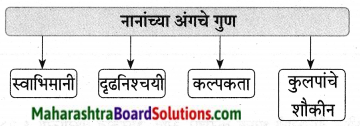
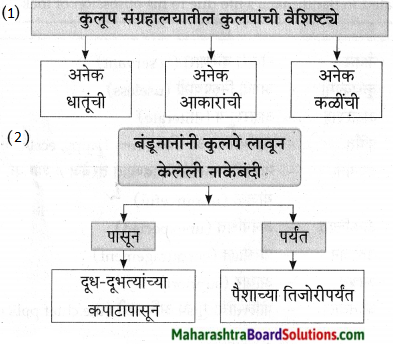


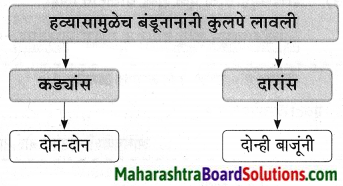




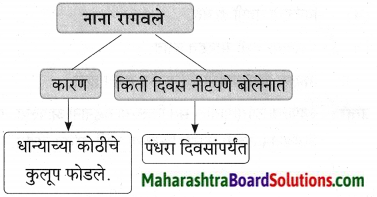

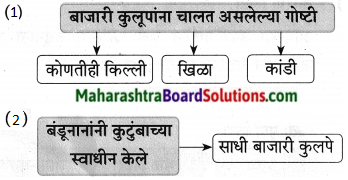
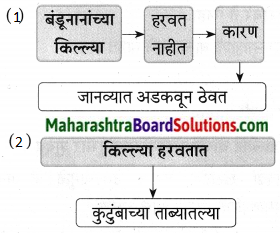

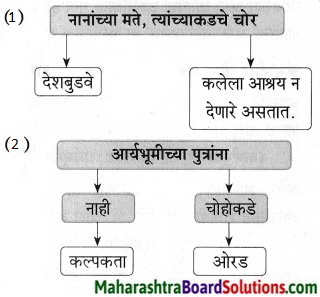
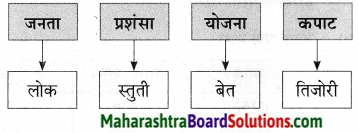

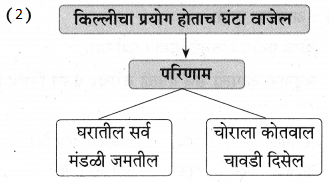
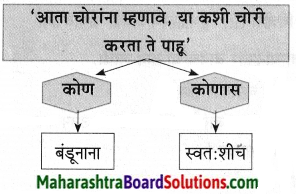
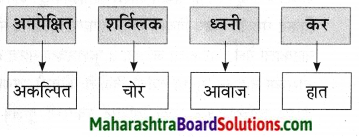
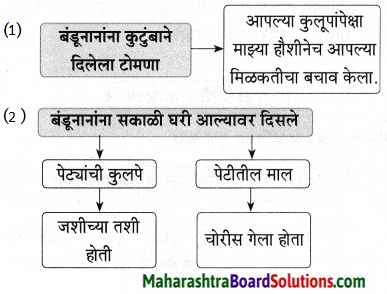


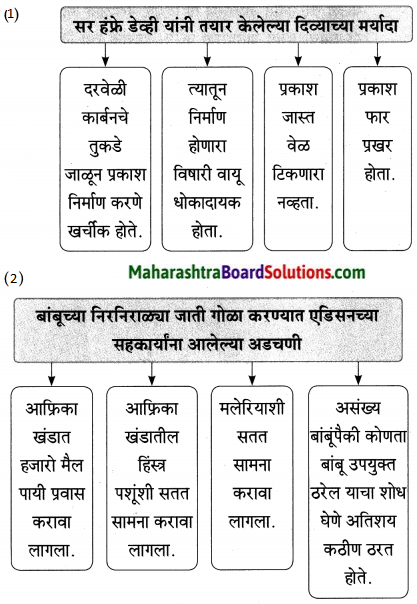

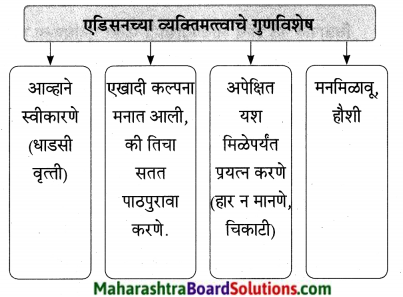

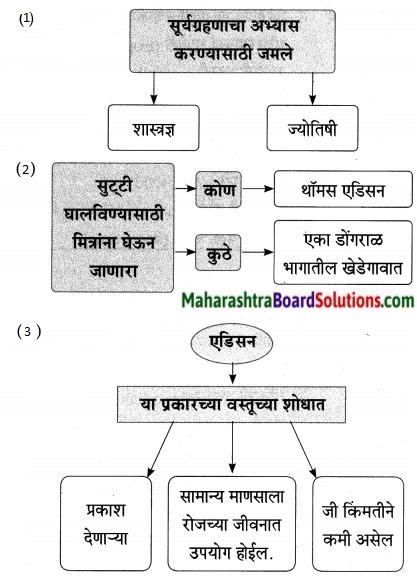
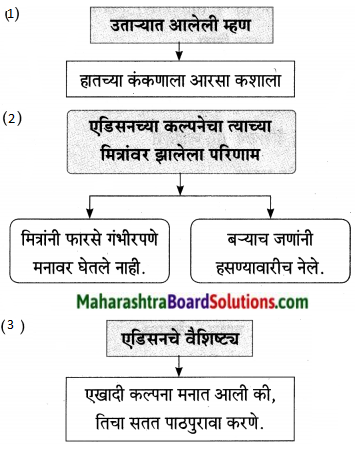
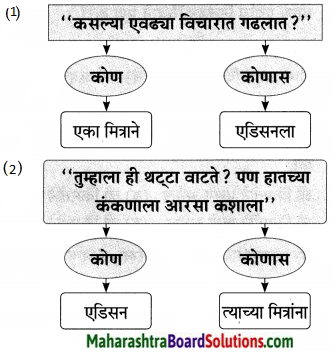

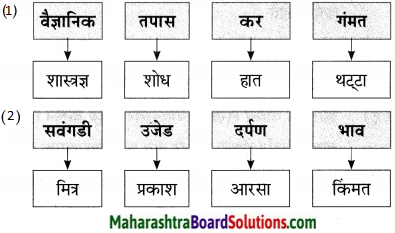
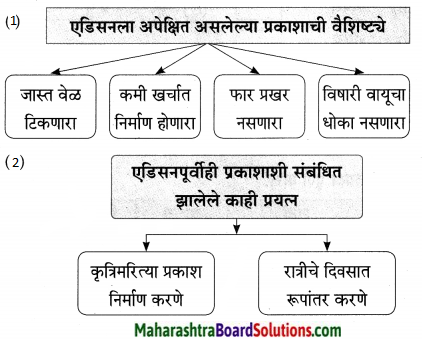
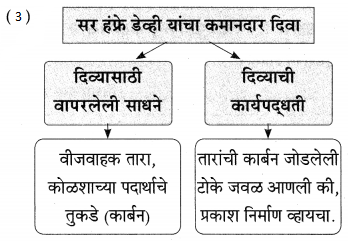
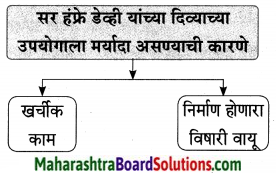
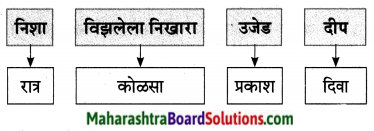

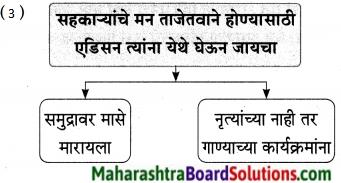
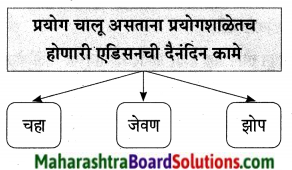
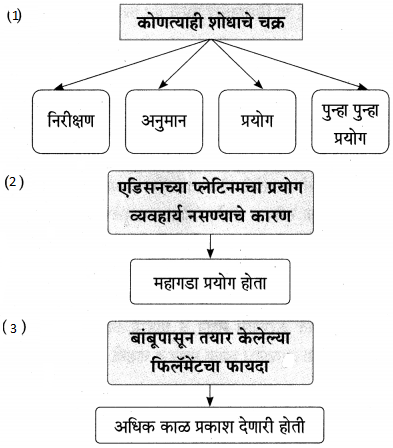
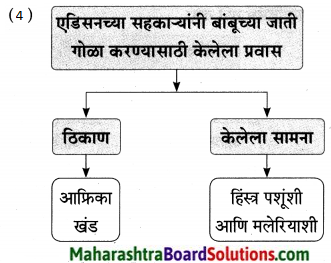 .
.
